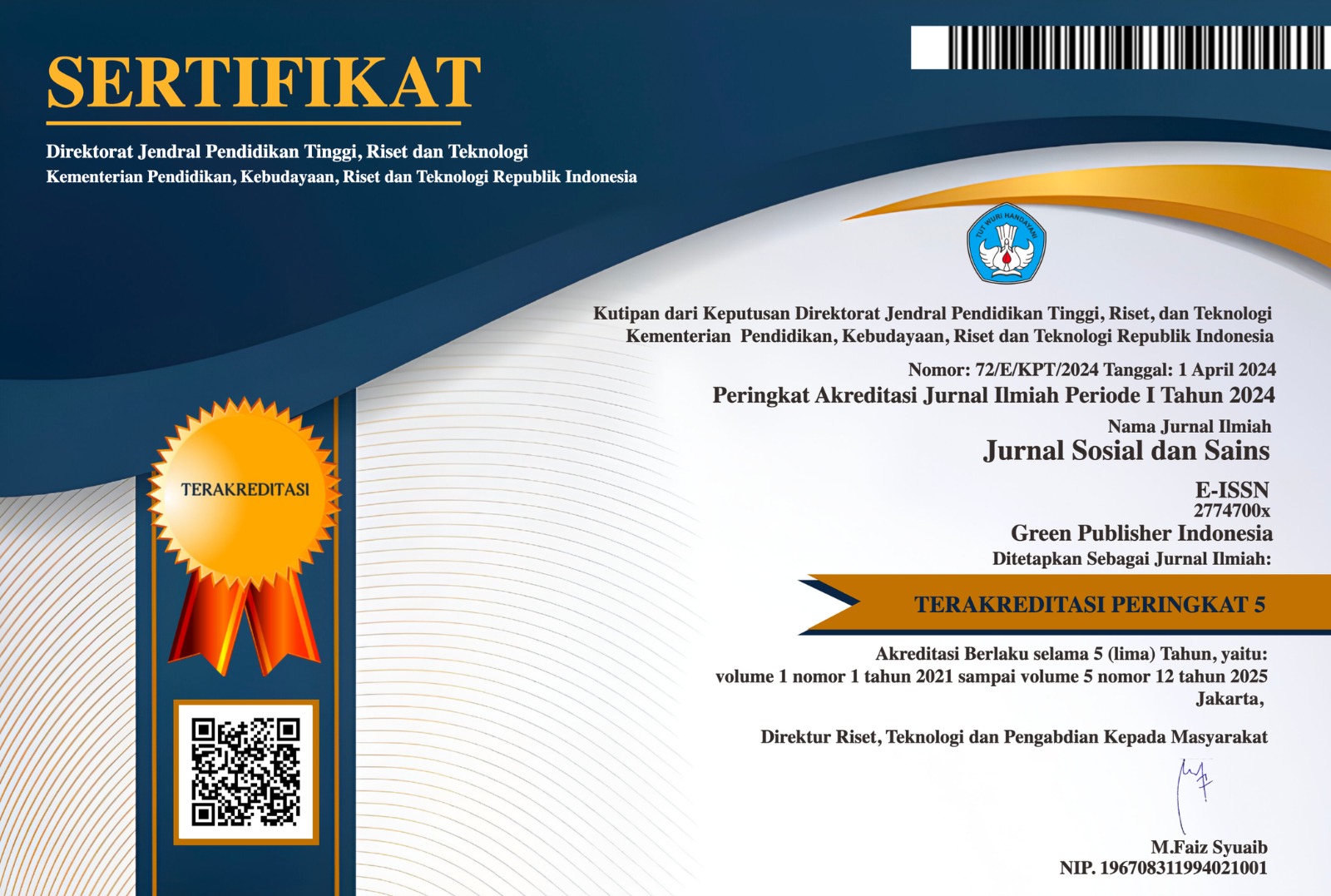Humor dalam Komunikasi Persuasif Mas-Mas Host Live Streaming di TikTok Batiksanarakarta
DOI:
https://doi.org/10.59188/jurnalsosains.v5i7.32392Keywords:
humor, komunikasi persuasif, Live StreamingAbstract
ABSTRAK
Latar Belakang : Dalam era digital, platform media sosial seperti TikTok berperan penting dalam pemasaran e-commerce di Indonesia yang terus berkembang pesat. TikTok menyediakan fitur live streaming yang memungkinkan interaksi real-time antara host dengan konsumen, meningkatkan kepercayaan dan memungkinkan demonstrasi produk secara langsung. Studi ini meneliti penggunaan humor oleh Mas Fajar sebagai host dalam live streaming akun TikTok Batiksanarakarta, yang terbukti memperkuat hubungan dengan audiens dan meningkatkan brand awareness. Penelitian menggunakan pendekatan kualitatif melalui observasi dan analisis konten live streaming. Hasil menunjukkan humor yang cerdas dan gaya komunikasi menarik Mas Fajar meningkatkan keterlibatan audiens dan memperkuat persepsi positif terhadap merek. Kesimpulannya, humor berperan sebagai isyarat periferal yang efektif dalam komunikasi persuasif digital, memperkuat interaksi dua arah dan kesadaran merek di platform TikTok. Temuan ini mendukung teori Elaboration Likelihood Model (ELM), pertukaran sosial, dan interaksi parasosial dalam konteks pemasaran digital.
Tujuan : Menganalisis bagaimana penggunaan humor oleh Mas Fajar sebagai host live streaming di TikTok Batik Sanarakarta berperan sebagai strategi komunikasi persuasif dalam meningkatkan interaksi dan keterlibatan audiens secara real-time.
Metode : Penelitian ini menggunakan metode kualitatif dengan pendekatan observasional dan deskriptif, serta analisis tematik untuk mengkaji gaya komunikasi Mas Fajar sebagai host live streaming di TikTok Batik Sanarakarta, terutama dalam penggunaan humor dan interaksi dua arah dengan audiens secara real-time.
Hasil: Penelitian ini menemukan bahwa humor yang digunakan oleh Mas Fajar sebagai host live streaming di TikTok Batik Sanarakarta berfungsi sebagai alat komunikasi yang efektif dalam membangun interaksi dua arah yang hangat dan akrab dengan audiens. Humor tersebut tidak hanya meningkatkan keterlibatan dan kehadiran sosial, tetapi juga memperkuat daya tarik pesan pemasaran sehingga mampu mempengaruhi minat beli penonton secara real-time.
Kesimpulan : Humor yang digunakan oleh Mas Fajar dalam live streaming TikTok Batik Sanarakarta efektif membangun interaksi hangat dan meningkatkan keterlibatan audiens secara langsung, memperkuat daya tarik pesan pemasaran dan minat beli. Penelitian ini menegaskan humor sebagai strategi komunikasi persuasif yang kuat sesuai dengan teori ELM, pertukaran sosial, dan interaksi parasosial.
ABSTRACT
Background: In the digital era, social media platforms such as TikTok play an important role in e-commerce marketing in Indonesia which continues to grow rapidly. TikTok provides a live streaming feature that allows real-time interaction between marketers and consumers, increasing trust and allowing for direct product demonstrations. This study examines the use of humor by Mas Fajar as a host in the live streaming of the Batiksanarakarta TikTok account, which has been shown to strengthen relationships with audiences and increase brand awareness. The study used a qualitative approach through observation and analysis of live streaming content. The results show that Mas Fajar's intelligent humor and interesting communication style increase audience engagement and strengthen positive perceptions of the brand. In conclusion, humor acts as an effective peripheral cue in digital persuasive communication, strengthening two-way interactions and brand awareness on the TikTok platform. These findings support the Elaboration Likelihood Model (ELM) theory, social exchange, and parasocial interaction in the context of digital marketing.
Purpose: Analyzing how the use of humor by Mas Fajar as a live streaming host on TikTok Batik Sanarakarta plays a role as a persuasive communication strategy in increasing audience interaction and engagement in real-time.
Methods: This study uses a qualitative method with an observational and descriptive approach, as well as thematic analysis to examine Mas Fajar's communication style as a live streaming host on TikTok Batik Sanarakarta, especially in the use of humor and two-way interaction with the audience in real-time.
Results: This study found that the humor used by Mas Fajar as a live streaming host on TikTok Batik Sanarakarta functions as an effective communication tool in building warm and intimate two-way interactions with the audience. The humor not only increases engagement and social presence, but also strengthens the marketing appeal of the message so that it can influence the audience's buying interest in real-time.
Conclusion: Humor used by Mas Fajar in the live streaming of TikTok Batik Sanarakarta is effective in building warm interactions and increasing direct audience engagement, strengthening the appeal of marketing messages and purchasing interest. This study confirms humor as a powerful persuasive communication strategy in accordance with the ELM theory, social exchange, and parasocial interaction.
Downloads
Published
How to Cite
Issue
Section
License
Copyright (c) 2025 Nur Laiela Hidayatur Rohmah, Hilda Nurhidayati

This work is licensed under a Creative Commons Attribution-ShareAlike 4.0 International License.
Authors who publish with this journal agree to the following terms:
- Authors retain copyright and grant the journal right of first publication with the work simultaneously licensed under a Creative Commons Attribution-ShareAlike 4.0 International (CC-BY-SA). that allows others to share the work with an acknowledgement of the work's authorship and initial publication in this journal.
- Authors are able to enter into separate, additional contractual arrangements for the non-exclusive distribution of the journal's published version of the work (e.g., post it to an institutional repository or publish it in a book), with an acknowledgement of its initial publication in this journal.
- Authors are permitted and encouraged to post their work online (e.g., in institutional repositories or on their website) prior to and during the submission process, as it can lead to productive exchanges, as well as earlier and greater citation of published work.








